Maa ki Dal recipe with step by step photos. At home all my folks are fond of black lentils (black gram or kali urad dal) or Punjabi kali dal recipe. This delicious and creamy Punjabi lentil dish is made with whole black gram (sabut urad dal), onions, tomatoes and the usual Indian spices. Comforting, filling and satisfying meal when served with phulka, roti, paratha or naan.
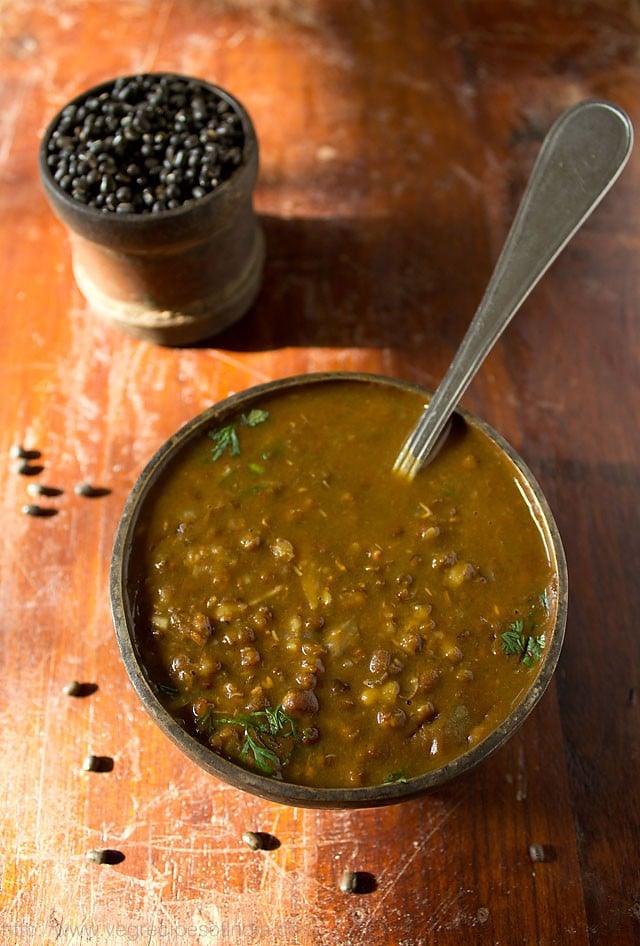
In Punjabi these lentils are called Mah di dal or maa di dal or manh di daal. At home everybody called whole black lentils as maa di dal.
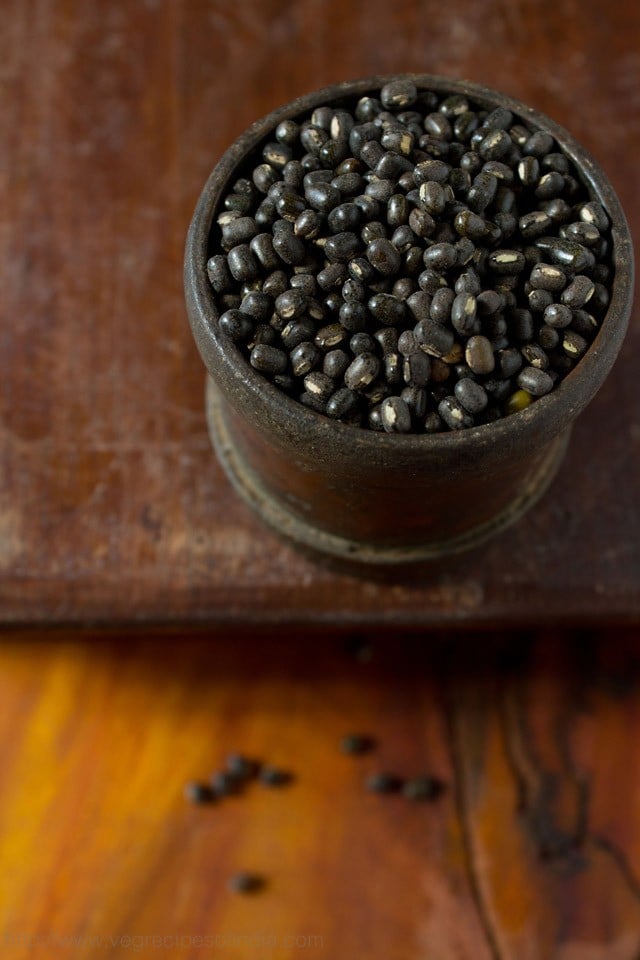
Maa ki dal is also known as kali dal, but it is not dal makhani. So let me tell you what is the difference between maa ki dal and dal makhani.
Maa ki dal or kali dal is made from whole black grams (black dal or kali urad dal or sabut urad dal) only. There are many ways of making this black gram dal recipe. It can be spicy or less spiced as well. It is also not a very rich and heavy dish as no extra cream, butter is added to it.
Whereas Dal Makhani is made from a mix of whole black grams, kidney beans (rajma), and some times chana dal. It is a rich dish as it is made with butter, cream and sometimes yogurt too. It is a makhani dish.
Makhani means buttery. The word makhani is derived from the Punjabi word Makhan which means Butter. So dal makhani is a buttery creamy rich dish.
So kali dal or maa ki dal is not dal makhani. They are two different dishes. Just to let you know there is another Punjabi dish called maa chole di dal – this is made from black lentils and chana dal. It is a staple at my home.
Usually, at home I cook Dal fry, Dal tadka, various sabjis, pulao, khichdi, idli, dosa, sambar. For me these are simple, comforting foods.
This recipe of kali dal is a light recipe with a spicy touch to it. I have made this with sunflower oil and no butter or ghee. For a more richer version you can make it with butter or ghee. You could also add some cream in the end if you prefer.
The main ingredients of this star dish besides whole black gram are onions, green chilies, tomato puree and crushed ginger-garlic sauteed with Indian spices.
Generally maa ki daal is cooked and simmered in a pot. In a modern day life we don’t have the luxury and leisure to let our dals cook in pots. The black lentils take a lot of time to cook in a pot.
I have cooked the dal in a stovetop pressure cooker. It is a quick cooking method and what might take hours, just gets done in 30 to 40 minutes. If you have Instant pot then you can also make this dish in it adding water as needed.
Also remember to use fresh lentils as they cook faster compared to aged lentils. I also recommend to soak the lentils for some minutes prior to cooking. Soaking lentils reduces the cooking time and also helps in getting rid of the phytic acid in them.
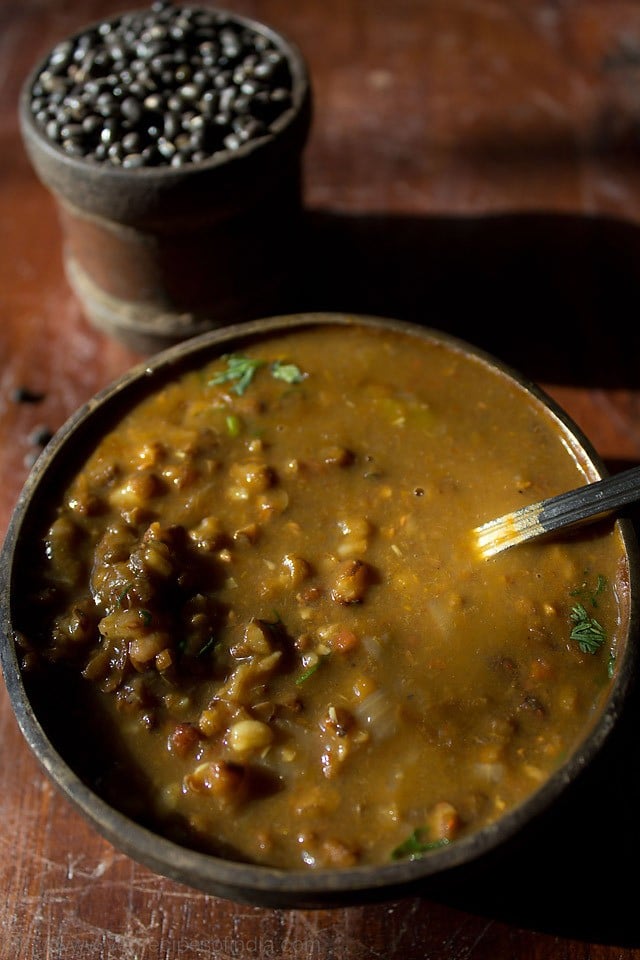
Maa ki dal goes very well with roti, naan and even rice. So if you are fond of Punjabi dishes, then do try this awesome kali dal recipe. You and your family are going to love it. You don’t have to trust me. You have to make this at home and relish the maa di dal.
How to make Kali Dal or Maa ki dal
1: Pick the sabut urad dal (whole black gram with husks), rinse in water for 2 to 3 times. Later drain the water and soak the lentils in enough water in a bowl for about 30 to 40 minutes.
The soaking time can vary depending on the quality and age of the lentils. Sometimes even after soaking for an hour or so, these aged lentils take a lot of time to cook.
So you can soak sabut urad dal overnight or for some 4 to 5 hours. So if using old lentils or lentils near expiry date, soak them overnight. Later, drain the soaked dal.
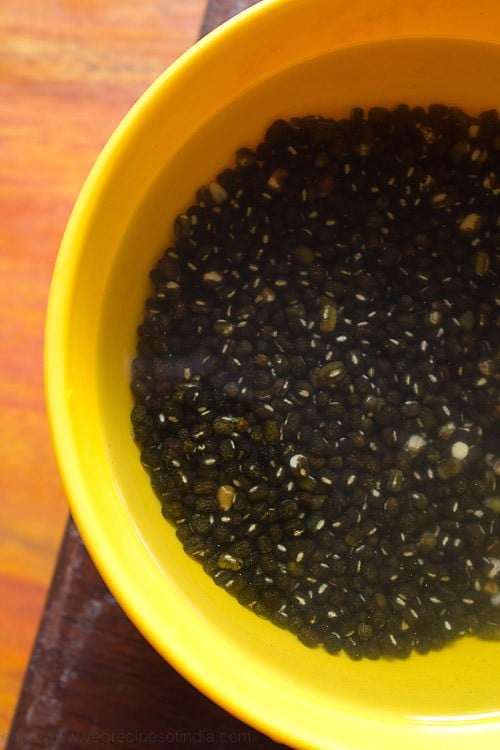
2: Heat 2 tablespoons of ghee or oil in a 3 litre stovetop pressure cooker. Instead of ghee you can also use butter.
Add ½ teaspoon cumin seeds. Keep the heat to low. When they sizzle and crackle, add 1 medium-sized chopped onion (about ⅓ cup chopped onions).
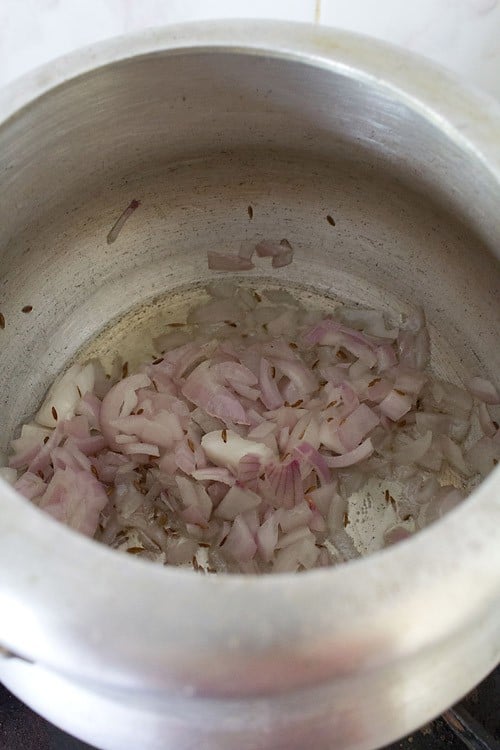
3: Stirring at regular intervals, fry the onions till light brown or golden on low to medium-low heat.
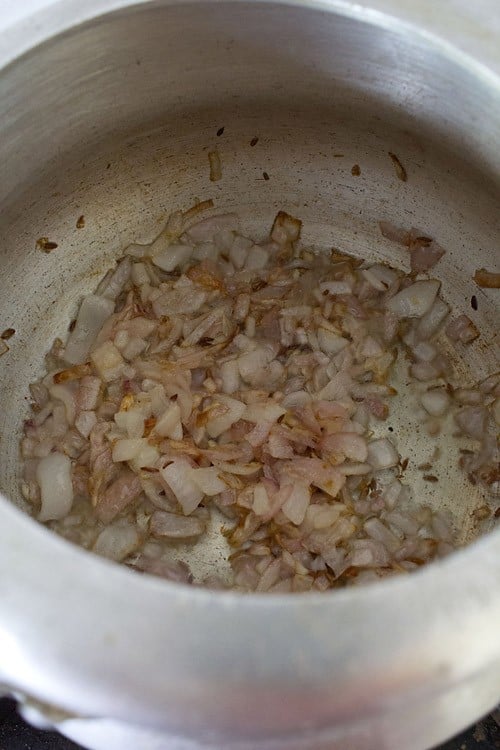
4: Now add the pureed tomatoes. Stir and mix well. I have pureed or blended 2 medium sized tomatoes in a blender and this yields about 1 cup of tomato puree.
You can easily swap fresh tomato puree with canned tomato puree.
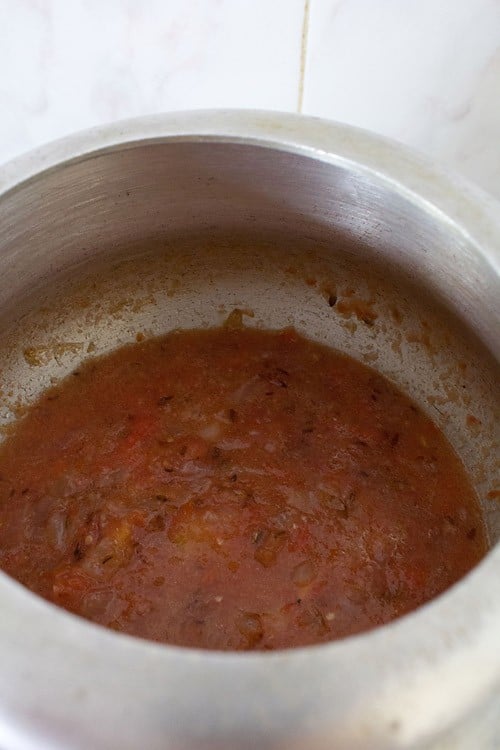
5: Add the crushed ginger and garlic – about 3 to 4 small to medium-garlic cloves and 1 inch ginger crushed in a mortar-pestle. Or add 2 teaspoons ginger-garlic paste instead.
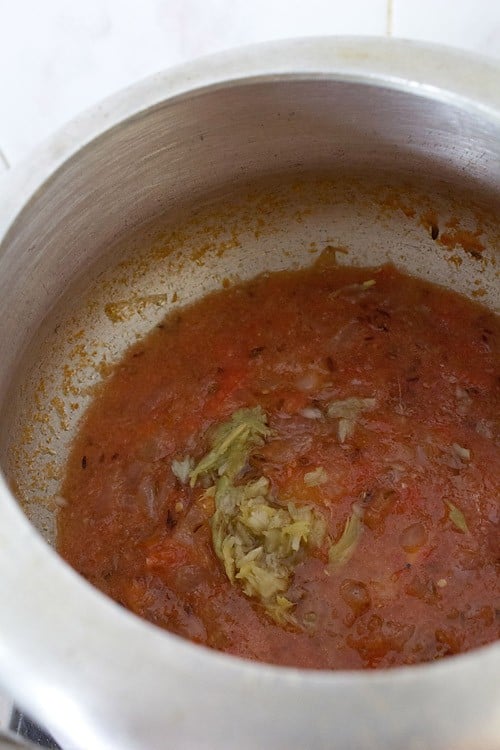
6: Add all the dry spice powders. In this below photo I have added the following ground spices one by one:
- 1 teaspoon coriander powder
- ½ teaspoon turmeric powder
- ½ teaspoon red chili powder
- ¼ teaspoon garam masala powder
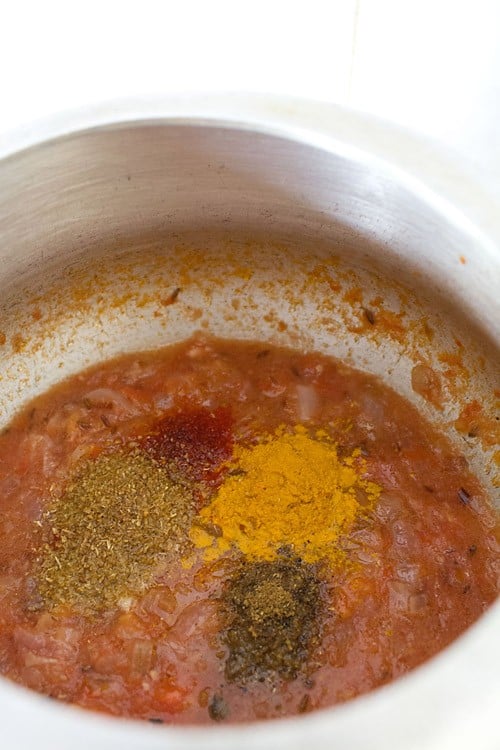
7: Stir the spice powders and mix well.
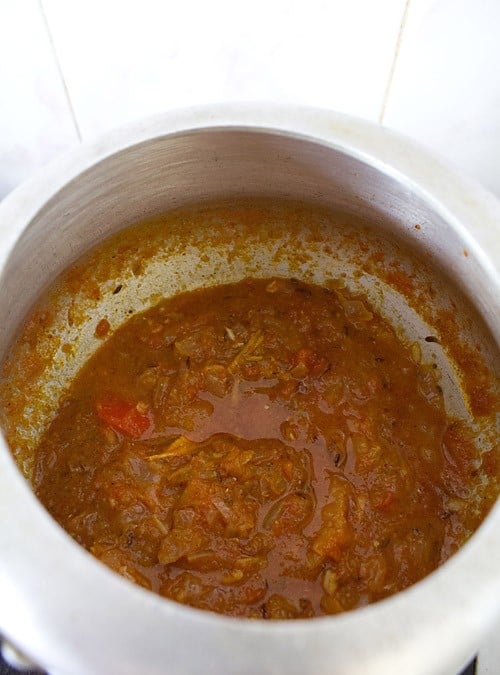
8: Then add 1 finely chopped green chili or ½ to 1 teaspoon chopped green chillies.
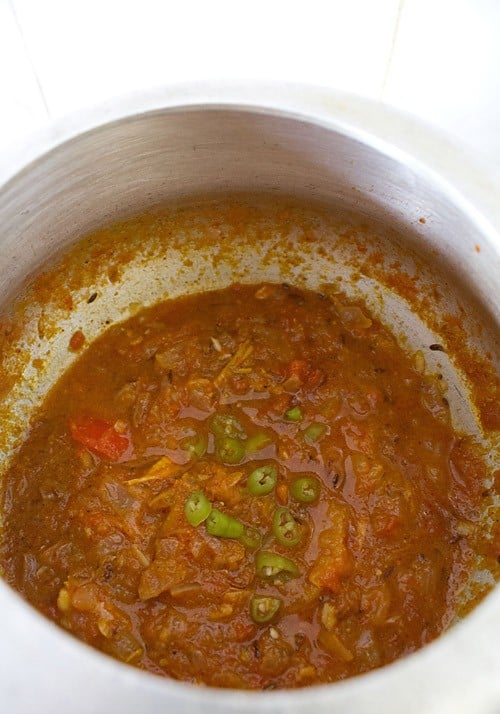
9: Sauté the masala stirring often on a low to medium-low heat till the oil starts to leave or separate at the sides. Take care the masala does not burn while sautéing.
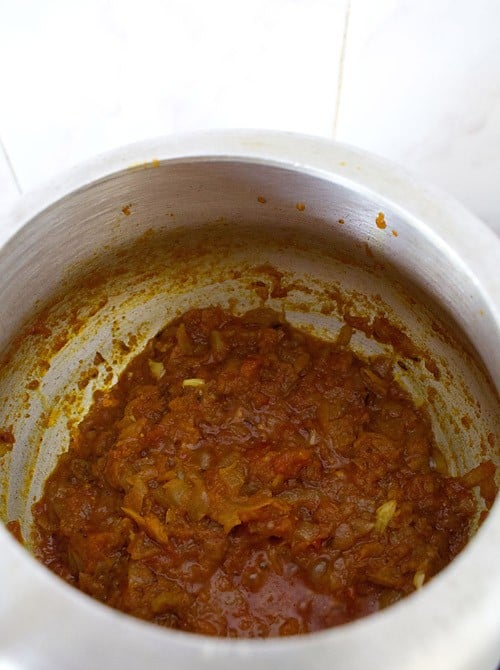
10: Add the drained and soaked sabut urad dal (black gram).
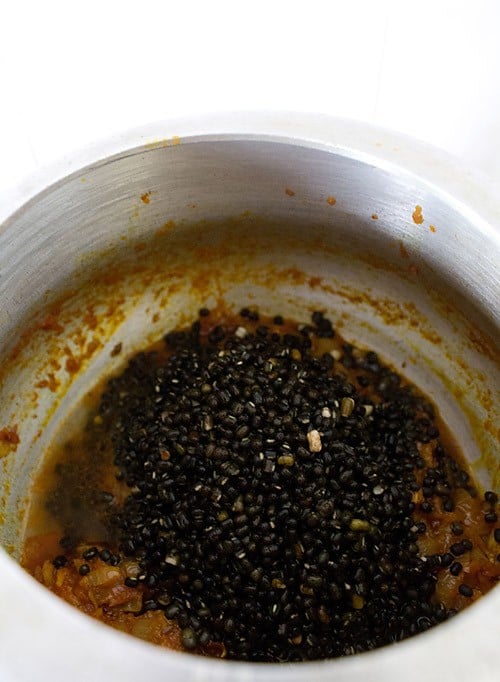
11: Add 3 to 3.5 cups of water and salt as required. Stir and mix well.
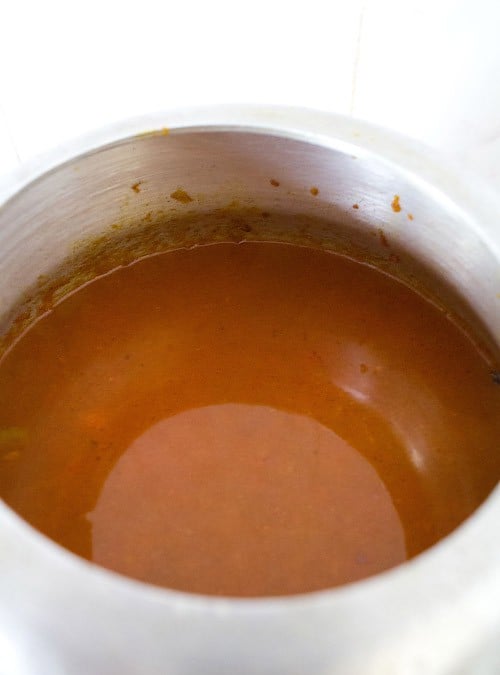
Cover the pressure cooker with its lid and pressure cook the dal for some 20 to 25 minutes on medium to medium-high heat till the lentils are soft, tender and thoroughly cooked. When the pressure falls down naturally in the cooker then only open the lid.
Simmer the lentils on low to medium low heat stirring often. Mash some lentils with the spoon whiles the lentils are simmering. This helps to thicken the consistency of the dal.
Cook and simmer till you get a creamy consistency. I kept the maa ki dal a little thin as we prefer thin dals in summer. You can keep the consistency as per your preference.
Garnish it with coriander leaves and serve maa ki dal hot or warm with naan, kulcha, rotis or plain paratha. You can also have it with steamed basmati rice.
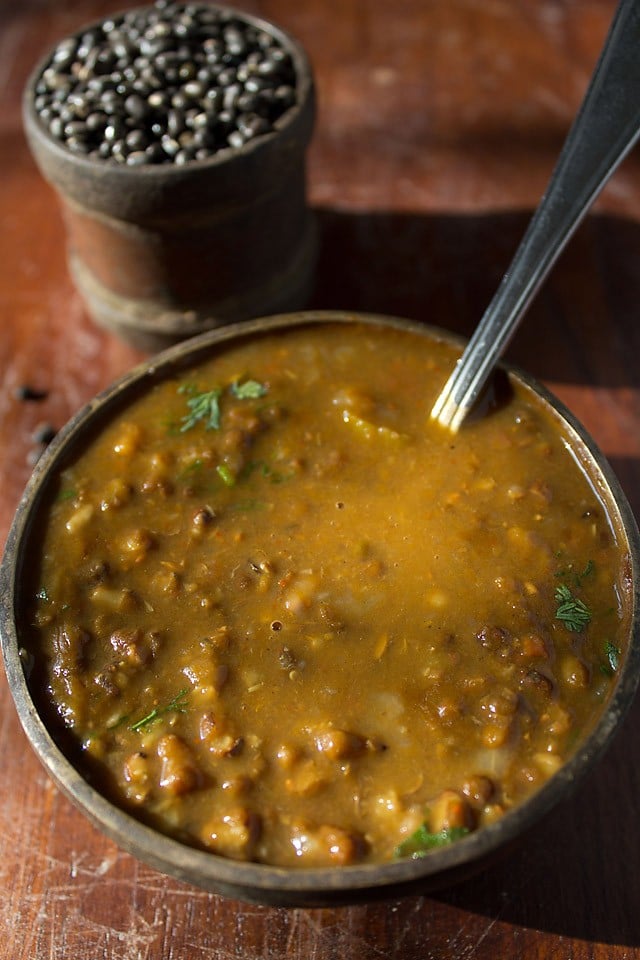
Please be sure to rate the recipe in the recipe card or leave a comment below if you have made it. For more vegetarian inspirations, Sign Up for my emails or follow me on Instagram, Youtube, Facebook, Pinterest or Twitter.
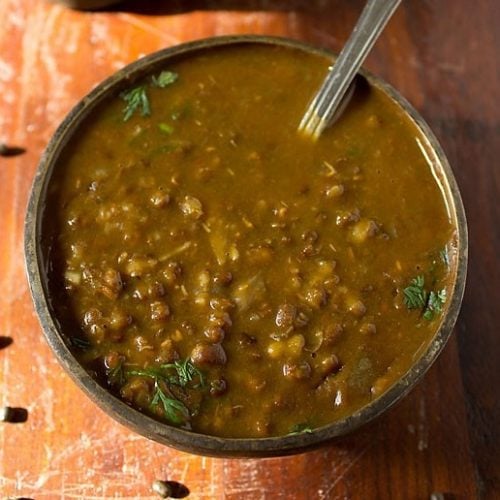
Kali Dal | Punjabi Black Dal (Maa Ki Dal)
Ingredients
- 1 cup whole black lentils (sabut urad dal or black gram)
- 1 medium onion – chopped or ⅓ cup chopped onions
- 2 medium tomatoes pureed – yields approx 1 cup tomato puree
- 2 to 3 garlic cloves small to medium – crushed in a mortar-pestle
- 1 inch ginger – crushed in a mortar-pestle
- 1 green chili – finely chopped or ½ to 1 teaspoon chopped green chillies
- 1 teaspoon Coriander Powder (ground coriander)
- ½ teaspoon cumin seeds
- ½ teaspoon turmeric powder (ground turmeric)
- ½ teaspoon red chili powder (or cayenne pepper or paprika)
- ¼ teaspoon Garam Masala
- 2 tablespoons oil or ghee or butter
- 3 to 3.5 cups water or add as required
- salt as required
- 1 to 2 tablespoons coriander leaves for garnishing, optional
Instructions
Soaking Lentils
- Pick the sabut urad dal and rinse in water for 2 to 3 times and soak it in water for 30 to 40 minutes. You can also soak the lentils for 4 to 5 hours or overnight, depending on the quality of dal. If the lentils are old or near expiry date, then soak overnight.
- Later drain the soaked sabut urad dal.
Making maa ki dal
- Heat ghee or oil in a 3 litre stovetop pressure cooker. Instead of ghee you can also use butter. Keep the heat to low. Add the cumin seeds. When they sizzle and crackle, then add chopped onions.
- Fry the onions stirring often till light brown or golden on low to medium-low heat.
- Add the pureed tomatoes. Stir and mix well.
- Next add the crushed ginger-garlic or ginger-garlic paste.
- Add the all the dry spice powders – coriander powder, turmeric powder, red chili powder and garam masala powder. Stir the spice powders and mix well.
- Add chopped green chilies.
- Saute the masala on a low to medium-low heat till the oil starts to leave or separate at the sides. Ensure that the masala does not burn while sauteing.
- Add the soaked sabut urad dal (black gram). Add water and salt as needed. Stir and mix well.
Cooking maa ki dal
- Cover the pressure cook for about 15 to 18 whistles or 18 to 20 minutes or till the lentils have become soft and buttery. If still they are not cooked well, then continue to pressure cook for a few more whistles.
- When the pressure falls down naturally in the cooker then only open the lid.
- If the dal looks thin, then simmer without the lid, till it reaches the desired consistency.
- Garnish with coriander leaves.
- Serve maa ki dal hot with naan, kulcha, rotis, plain paratha or plain boiled rice.
Nutrition Info (Approximate Values)
This Black Dal recipe from the blog archives first published in April 2012. It has been republished and updated on January 2022.
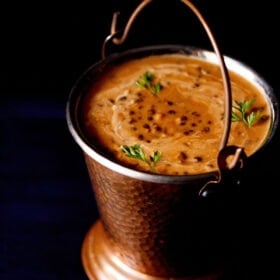
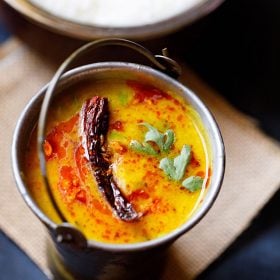
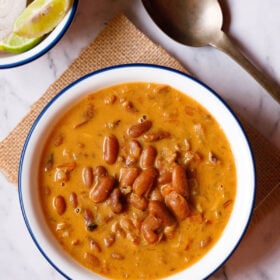
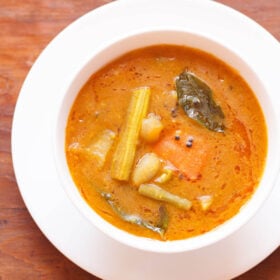








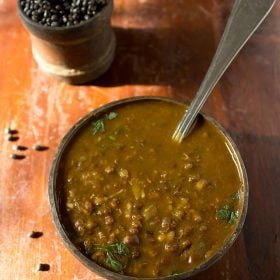
Very good and tasty recipe.👍👍👍
I made a comment the other day – you don’t seem to have received it. I’ve signed up for your beginner’s guide and I’m very excited about it! I cook with cast iron pans and I wondered if there was anything more I needed to know cooking this way. I am about to make the Ma Ki Dal and I know it will be good! Thank you!
Hello Dassana! I live in France and I’ve just come across your very exciting blog! I have 2 questions:
Can this Dahl be made with green lentils (easier to find)? I don’t use a pressure cooker – most of my cooking is done in a cast iron pot.
Does this matter? I wouldn’t think so but I’d like to be sure.
For green lentils, you can have a look at this recipe of Green Lentils which has a different flavor and taste than this one.
Green lentils can be easily cooked in a pot. Even these lentils can be cooked in a pot. But remember to soak them for some 4 to 5 hours or overnight. In fact lentils cooked in a pot taste better than the pressure cooked lentils.
Tried yesterday, it was really awesome.. The taste was so good, I can’t explain in words. I am following your recipes since long and found each one worthy for me. Thank you.
Thanks so much and so glad to know. Thanks for the rating also on the recipe. Most welcome.
I will try soon. Explained very clearly, thank you
Thanks.
I’m going to try this soon. I love your explanations, and I look forward to trying more of your recipes. Thanks!
Thanks a lot and I hope you like the recipes.
I have not tried the recipe yet because I have a question–could I make this in a crock pot? It seems like I could start the beans and then add the savories during cooking. What do you think?
I am excited to start making more Indian food and have signed up for your emails!
Yes you can do that. Recipes like these can be made in the crock pot. Do let me know how it goes for you. Thank you.
Hi Dassana, thank you for this post. It’s incredible. I just made it step by step! And it’s so creamy and delicious!
I’ve never used a pressure cooker before, I had to give a couple of tries, but I called mum and she helped me! The daal is insane! Thank you again.
Hi Nim, thanks for the super feedback on the recipe and also thanks sharing your experience making this recipe. Glad that your mom helped. Most welcome.
Absolutely delicious! I added a teaspoon of plain Greek yogurt to my bowl when I ate it. Amazing combination of spices.
Thanks a lot.
Thank you for posting such amazing recipes with simplified steps which are so easy to follow. I only started cooking now and your blog has been my teacher. Any dish I think of I first some here to check if you have the recipe and I have almost always found what I am looking for as your collection is so comprehensive. Sincere thanks for your efforts and may your blog continue to keep inspiring and guiding novice cooks like me.
Thanks a lot Madhu. Felt nice to read your lovely comment. I am glad that the recipes are helpful during these times. Thanks again and I wish you all the best. Stay safe and take care.
I have tried a lot of your recipes and every recipe has come out really well 😊
Your blog is my favourite whenever I am cooking anything vegetarian.
Thanks a lot Grishma and glad to know. Happy Cooking.
Very good in taste
Thanks for the feedback.
Dear Dassana,
You really are awesome cook. I love following your recipes.Its always a hit when I have parties at my house. Keep it up you are doing awesome job with step by step explanation of each recipes.
Reena
Thanks a lot Reena and I am glad that you have liked the recipes. Thanks for sharing your feedback. Stay Safe.
Dear Dassana,
Is there a particular reason why after frying the onion, you add the tomato puree first and then the ginger and garlic and not the other way around, as in most of your recipes? Just curious ???? Thanks!
hi esther, there is no particular reason. you can add it either way. the taste will be same – the ginger-garlic just need to be sauteed and cooked well. welcome and hope this helps.
Hi
I wish to cook this in slow pressure cooker or instapot
Can you sugges how much time I would need
Thanks
hi padmaja., i recently made dal makhani slow-cooked in instant pot. i kept for a time of 12 hours as even after 9 hours the lentils were not softened. initially, i had kept for 9 hours but then increased the time. i had used presoaked lentils. i would suggest you to make this maa ki dal in a slow cooker and not an instant pot. the reason is that an instant pot does not slow cook as good as compared to a slow cooker. it is best for pressure cooking. in a slow cooker, you can keep for 8 hours. hope this helps.
is sabut masoor daal also called ‘ma ki daal’? Because in some parts of UP, masoor daal is said to symbolise a goddess (ma) … and could ‘ma ki daal’ also have a similar origin?
as far as i know, sabut masoor dal is not called as maa ki dal. i have read about masoor dal symbolizing the goddess. could be that maa ki dal has a similar origin, that we are not aware of. in fact, urad dal is originally from india and is mentioned even in the ancient texts.
Thank you for this recipe!!!
welcome.
I loved all the recipes reffered by Dasana .
thank you lakshmi priya.
Came out well. Hope to make it better the next time
loved it. The ease simplicity and taste was great.
thanks swati for this feedback on maa ki dal recipe.
How old is this recipe? Has it been passed down from generations? Thank you. Great dish!
Welcome Victoria. I learnt it from my mother in law. she has been making it for many years.
Thnx…your recipe is easy to understand..
welcome apurwa.
In pressure cooker we have to cook for how many whistles? Usually urad dal takes 4-5 whistles. Pls confirm. I cook toor dal in cooker for 3 whistles n it’s cooked properly.
the time taken for cooking dals largely depend on their quality. usually whole urad dal takes more time to cook then white urad dal or toor dal. so you can cook for 8 to 10 whistles first and then check. if the dal is not cooked, then continue too cook for more whistles.
So far i hv made so many of ur dal recipes. All big hit. Today i hv made this maah ki dal. Though no one hs tasted it yet…am pretty sure this too is gonna big hit. Thank u so much fr th recipe.
welcome supreeta. glad to know this. thanks for sharing your positive feedback.
Hi,
I want to make this recipe.
I just have one question before I do.
I am going to use 500grams of the Dal.
How should I change the spice and other ratios?
Thanks.
Welcome Irvin. I am afraid I can’t help you in this because i have not measured the weight of 1 cup of lentils in grams.
Hi thanks for your recepie. I wanted to know can i pressure cook whole lentils? Instead of soaking it?
you need to soak them for at least an hour. so you can soak them in water for an hour or two. if in a hurry, then just soak them for 30 minutes in hot water.
I just made this dal and it was delicious! I’ve made 4 dal recipes from your website and they’ve all been fantastic. This dal is quite mild (I went easy on the chili) and so comforting to eat. I look forward to making more of your recipes.
Thanks Izabela for your positive feedback. Will keep adding more recipes.
One explanation for the name Ma-ki-dal is this dal has nutrients like mother’s mik( breast milk) hence the name?.
I tried the recipe it turned out really very good.
sumedha, thanks for this info. glad to know that you liked the dal.
Hey .. tried this recipe .. It was super hit!! enjoyed it. Thanks alott
thanks sulekha for this feedback.
Tried this recipe today, Iam a South Indian and it was first tym to make dal using black gram, it was super tasty . god bless for ur work 🙂 . I also request u to post sindhi Sai bhaji and rajasthani ghatte ki sabji . waiting from long tym …. 🙂
thanks for positive views. we have taken your both recipe requests on our file. please allow us some more time to post the same, thanks.
I tried this recipe and turned out extremely good. All my friends liked it very much
thank you kalyani.
Thank you so much for gng such a fabulous recipes..
I make each n every item at my kitchen.. by referring your’s recipe. . N every1 at my home appreciate d food prepared by me.. n my in laws always live me for ds.. thank u so much.. to make me a good cook
you are always welcome 🙂 pleased to know this priti and thankyou for your kind and positive words.
P.S: and Kaali Dal here is made with Saaboot Masoor Ki Dal or Whole Masoor.
uzra, good to know this.
Hi Dassana,
Came across your site while searching for authentic recipes. Usually I don’t comment but I thought I had to when I read that even your husband and MIL did not know why Mah dee Dal is called Mah.
I am from across the border and have spent a lot of time in the Punjab on the other side but now live overseas.
The national language here is Urdu and in Urdu, Urid Ki Dal is called Maash ki Dal but the Punjabis here shortened it and spoken in the Punjabi accent it sounds like Maah Di Dal.
Hope that helps 🙂
Keep those delicious recipes coming.
Warm regards,
Uzra
Thanks Uzra for sharing this info. most of us don’t know the history. good to know this.
Hi
I love your way of explaining the recipe with pictures of each step. You explain every dish so easily.Really awesome.Thanks alot my friend.
thanks preet.
Hi dassana, thank u very much for your kind reply n detailed explanation n instructions… it will really help me a lot…Thanks again for noticing my query.. i really appreciate your help…
welcome snehal. feel free to ask any query in future also.
Hi dassana.. love this recipe…. just wanted to know… do I need to cook the tomatoes before pureed…and can u plz tell me…how do u make tomato puree always for curries n subzi…with cooked or raw tomatoes…
You can make tomato puree either with raw or blanched tomatoes. I make either depending on the time constraints. Just chop the tomatoes and add them to the blender. To make a smooth puree from raw tomatoes, you need to have a good blender. Otherwise the skin and seed particles can be seen. For blanched one, boil water. Add tomatoes and cook for 1 to 2 minutes. Then switch off and cover the pan with a lid for 20 to 30 minutes. Drain and peel the tomatoes. The peels come out easily after you blanch the tomatoes. Chop and puree them.
Thank you so much for this fantastic recepie. Tried this today, extremely simple to make and turned out really delicious.
welcome himali. glad to know that you liked the mah ki dal recipe.
Dassana,
Something is terribly wrong with how I’m understanding this recipe. I did everything exactly as you have stated, and instead of 30 mins, I soaked the dal for an hour; instead of 12-15 whistles, I gave it 25 whistles continuously, but it still came out totally uncooked and hard as ever. Then I gave it 20 more whistles, and it still was hard as new. Then I got pretty fed up, and mashed the dal slightly with a pestle, and gave it 25 more whistles. AND IT STILL WOULDN’T COOK totally (It was cooked halfway, but not totally)!! So, I simmered it for 15 mins more, and had it anyways.
I talked with my mother, and she told me that I needed to soak urad overnight at least. She also said that I shouldn’t add the Garam Masala before the whistles as it interferes with the cooking.
Please help me out!!
hi manan. its not your fault. i have had issues like these but with rajma. and that too rajma which have been soaked overnight. i pressure cooked the rajma for more than 1 hour and they were still uncooked. i found out that its the quality of rajma and old beans take a lot of time of cook. urad dal can be soaked for about 30 mins to overnight. but when i made this, i had soaked them for about 30 mins. i did not have any problem. however, when i make dal makhani, i do soak the urad dal and rajma overnight. so its the quality of urad dal.
still, i am really sorry you had to go through all this trouble. i will update the post mentioning better to soak for a few hours or overnight. regarding the garam masala, you can add it towards the end or during cooking. if its pukka garam masala (which means garam masala which has been roasted and then ground) then this is added towards the end. if its kachcha garam masala (spices which have been sun dried and then ground or just ground). then this is added while cooking.
My problem is that I always feel like my masala lacks flavor. I used the same measurements but find the taste bland. I wonder why?!
you can throw some light on how you prepare… also do you use homemade masala like coriander powder, garam masala powder or readymade.
we dnt need to gve a whistle to it??
i tried this but all on vain
i am unable to understand hw to cvr d cooker??
we just need to covr it or need to tightly close it??
pressure cooker needs to be tightly closed. otherwise how the pressure will be created by the steam inside. while pressure cooking, whistles will happen. i haven’t mentioned the whistles as most home cooks will know the time needed to cook the dal. but after your comment, i will add the number of whistles as most novice cooks won’t understand. thanks.
Best for lunch or dinner very nice pictures thanks for posting
welcome pravina
Tried three of your recipes this week – this was one of them. All were very good and not too complicated. Thanks!
welcome modibo
Tried your recipe for Maa ki daal.Superb.Hit it with Cream.Heaven.3 of us polished the pot with hot rotis.Kudos.
thanks jay. nice to know that you all liked the maah ki dal.
Hi
The images are not visible in ipad.
Earlier it was working.
Now not working.
Please check
Thanks
Shalini
thanks shalini for the feedback. i will check why the images are not showing.
awesome recipe that was, must say the typical indian taste and aroma cud be felt
thanks aiman
great recipe
hello dasanna i really really wnt to thnk u for this wonderful recipe i tried ur recipe and it turned out great it really made my day.Two days back only i visited ur blog for d first time n hve bcme really a fan of urs and m looking forward to try ur other recipes
thanks and welcome jayshree. you can also try the other recipes.
thanks for the recipe 🙂
welcome
Hello Dassana,
It looks yummy. Wl try it today only.
Have tried your MASOOR DAL recipe and it came out delicious.
Thanx a ton
every1 loved it
M a big fan of your’s..
Keep writing the blog…
U r an inspiration for young gals like me… 🙂
thanks arpi for those words.
Hi Dassana…
First of all congratulations to you for posting this typical, authentic, punjabi home recipe of ‘maah ki daal’
I am a maharashtrian not a punjabi..and all these years I always believed that Punjabi food is heavy n rich with loads of cream, paneer, milk, butter n ghee..
This was until I met a very good friend and neighbour..Amita who is a hard core punjabi..
Once she happened to cook this ‘Maah Rajma’ (she had also mixed a fistful of rajma in it) and it was awesome..She had cooked it so well and it was simply delicious..she told me this is ‘ghar ki daal makhni’. It was then that she explained that punjabi’s dont eat such heavy food on a daily basis and at home they cook such simple recipes.
When I asked her about the recipe it was just as the same u have posted..
Believe me all these years I have searched things on the typical popular websites who give only selected recipes..
Actually its late since the time you have posted this one, that I have found your recipe but I am very happy that I have got it..I will surely make it this weekend to surprise my dear friend with my Punjabi Cooking,,hahaha..
Also would like to know the secret behind smooth and fluffy Idlis..and your ‘Cooking with Pictures’ idea is a hit..I liked it..
All the best to you..and happy cooking..
Waiting for nice recipes for readers like us..
Love n Regards,
Shreya.
thanks shreya for all your appreciation.
punjabi food which is usually served in restaurants is loaded with butter, cream or ghee. its very rich. but at home when we cook, the food is really simple and healthy. your punjabi friend is right. what i have seen at home is that the main dishes like sabzis, curries and rice based dishes are not loaded in fats. but the stuffed parathas my mil makes are loaded with ghee and had with white butter. the morning breakfasts are usually heavy in calories and sometimes also includes dishes aloo poori or poori chole.
there are a lot of punjabi recipes on the blog. you can try some of them. here’s the link: https://www.vegrecipesofindia.com/recipes/punjabi-recipes/
for soft & fluffy idlis, its the temperature and fermentation that matters the most. by now after so many trials and errors i have learnt the art of making perfect idlis and dosa 🙂
if you want to get regular recipe updates, you can subscribe through email or twitter or google+. or you can just check the blog when you have time.
thanks once again.
Hello Dassana:
My first time on your blog but love it already… thanks for sharing such wonderful creations – I live in Canada and find it hard to cook on week days but will definitely try some of your recipes on the weekend…
Again, great job and keep the blog running…
J
thanks julie. your comments are much appreciated. do try the recipes and give the feedback.
I love mah ki dal. It wasn’t made very often by my mom. We usually had a typical Maharashtrian fare at my place. We used to eat it at restaurants .
Your dal looks delicious! Would love to eat it with some hot chappati.
Hopped on over from Kiran’s Blog at the mention of mah ki dal. I love how authentic your dal looks. I lived in Chandigarh and parts of Punjab for a few years and fell in love with the dals. I never ate dals before that .
Loved the step by step pics 🙂
thanks ansh. in my house dal is a staple food. so i keep on making regular homemade ones and sometimes being innovative while making dals.
u know what.. its been too long since i made urad daal. I remember eating the ghee and cream filled version back at home which i never digested well. So I just went off of whole urad for a while.. Its time to give it a try again with a lighter version! this looks delicious!
do try this richa… actually there is no need to add cream and butter in kaali dal or dal makhani. when both mah di dal and rajma are cooked well, then the whole gravy becomes buttery and smooth.
The dal looks super yumm! Its breakfast time here and those idlis look so tempting! Do share your secret to making them so perfect soon!
there is no secret… it is just right fermentation at the right temperature.
Oh..I love kaali dal..but hardly make it now, as its not quite common in South India..enjoy it when I visit my mom’s place. Lovely clicks.
You have become a pakka Punju Dassana 🙂 …..good explanations in the post! I always make this dal with rajma and never make it alone coz thats how all love it at home, only thing is in dal makhani as you also mentioned in your post lots of cream or butter is added but when I make it on regular basis I dont add that but boil it nicely so that both maa”h” and rajma get mixed too well and give a creamy texture and then add the tadka!
I loved your Idli pic….too tempting, looking forward to see some post from you on south Indian recipes and the chutney looks yummy in the pic…..
in cooking punjabi food, i have become a paaka punju….. learnt so many recipes from mom in law.
when we make dal makhani at home, we don’t add cream at all. just a little butter or oil and we cook it really well as you have mentioned.
both the idli and green coconut chutney are recipes requested from readers 🙂 will post them shortly.
Hey I tried this recipie last night and it came out just great!! My husband loved it..thanks so much for the wonderful recipes!!
thanks alison for making the recipe and commenting as well. made my day 🙂
Looks so good. I have never really made kaali dal before. Time to try it!
you must try this dal chinmayie. the whole black skinned lentils have such an earthy flavor and taste… i think you may end up liking this.
Looks yum and so pics ..beautiful it looks